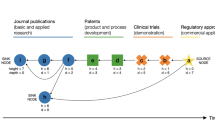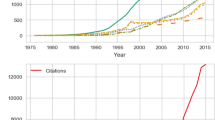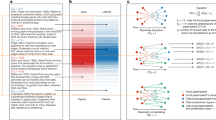Abstract
The empirical and theoretical justification of Gartner “hype curves” is a very relevant open question in the field of Technological Life Cycle analysis. The scope of the present paper is to introduce a simple model describing the growth of scientific/technological research impact, in the specific case where science is the main source of a new idea driving a technological development, leading to “hype-type” evolution curves. The main idea of the model is that, in a first stage, the growth of the scientific interest of a new specific field (as can be measured by publication numbers) basically follows the classical “logistic” growth curve. At a second stage, starting at a later trigger time, the technological development based on that scientific idea (as can be measured by patent deposits) can be described as the integral (in a mathematical sense) of the first curve, since technology is based on the overall accumulated scientific knowledge. The model is preliminary tested through a bibliometric analysis of the publication and patent deposit rate for organic light emitting diodes scientific research and technology.


Similar content being viewed by others
References
Bettencourt, L. M. A., Kaiser, D. I., Kaur, J., Castillo-Chavez, C., & Wojick, D. E. (2008). Population modeling of the emergence and development of scientific fields. Scientometrics, 75, 495–518.
Braun, T., Lyon, W. S., & Bujdosó, E. (1977). Literature growth and decay: An activation analysis resume. Analytical Chemistry, 49, 682A–688A.
Crane, D. (1972). Invisible Colleges: Diffusion of knowledge in scientific communities. Chicago: The University of Chicago Press.
Daim, T. U., Rueda, G., Martin, H., & Gerdsri, P. (2006). Forecasting emerging technologies: Use of bibliometrics and patent analysis. Technological Forecasting and Social Change, 73, 981–1012.
Fenn, J., & Raskino, M. (2008). Mastering the hype cycle: How to choose the right innovation at the right time. Boston: Harward Business School Press.
Godin, B. (2006). The linear model of innovation: The historical construction of an analytical framework. Science, Technology and Human Values, 31, 639–667.
Griliches, Z. (1990). Patent statistics as economic indicators—A survey. Journal of Economic Literature, 28, 1661–1707.
Gupta, B. M., & Karisiddappa, C. R. (2000). Modelling the growth of literature in the area of theoretical population genetics. Scientometrics, 49, 321–355.
Järvenpää, H. M. & Mäkinen, S. J. (2008). IEEE Proceedings “Industrial Engineering and Engineering Management” (IEEM).
Järvenpää, H.M. & Mäkinen, S.J. (2008). IEEE Proceedings Engineering Management Conference, (IEMC).
Järvenpää, H. M., Mäkinen, S. J., & Seppänen, M. (2011). Patent and publishing activity sequence over a technology’s life cycle. Tecnological Forecasting and Social Change, 78, 283–293.
Jun, Seung-Pyo. (2012). An empirical study of users’ hype cycle based on search traffic: The case study on hybrid cars. Scientometrics, 91, 81–99.
Menard, H. W. (1971). Science: Growth and change. Cambridge: Mass, Harvard University Press.
Palmer, P. J., Williams, D. J., & Hughes, C. (1999). Observations and models of technology trends within the electronics industry. Engineering Science and Education Journal, 8, 233–240.
Price, D. J. (1961). Science since Babylon. New Haven, Connecticut: Yale University Press.
Price, D. J. (1963). Little Science, Big Science. New York: Columbia University Press.
Steinert, M., & Leifer, L. (2010). Proceedings “Technology management for global economic growth” (PICMET).
Verhulst, P. F. (1845). Recherches mathematiques sur la loi d’accroissement de la population. In Nouveaux mémoires de l’Académie royale des sciences et belles-lettres de Bruxelles (Vol. 18, pp. 1–41).
Watts, R. J., & Porter, A. L. (1997). Innovation forecasting. Technological Forecasting and Social Change, 56, 25–47.
Yi, Su, & Han, Li-Feng. (1998). A new literature growth model: Variable exponential growth law of literature. Scientometrics, 42, 259–265.
Acknowledgments
The authors wish to thank Maria Grazia Maglione (ENEA) for sharing data on OLED market forecast and useful suggestions and Fabrizio De Filippis (University of Roma Tre) for careful reading of the manuscript.
Author information
Authors and Affiliations
Corresponding author
Rights and permissions
About this article
Cite this article
Campani, M., Vaglio, R. A simple interpretation of the growth of scientific/technological research impact leading to hype-type evolution curves. Scientometrics 103, 75–83 (2015). https://doi.org/10.1007/s11192-015-1533-6
Received:
Published:
Issue Date:
DOI: https://doi.org/10.1007/s11192-015-1533-6




